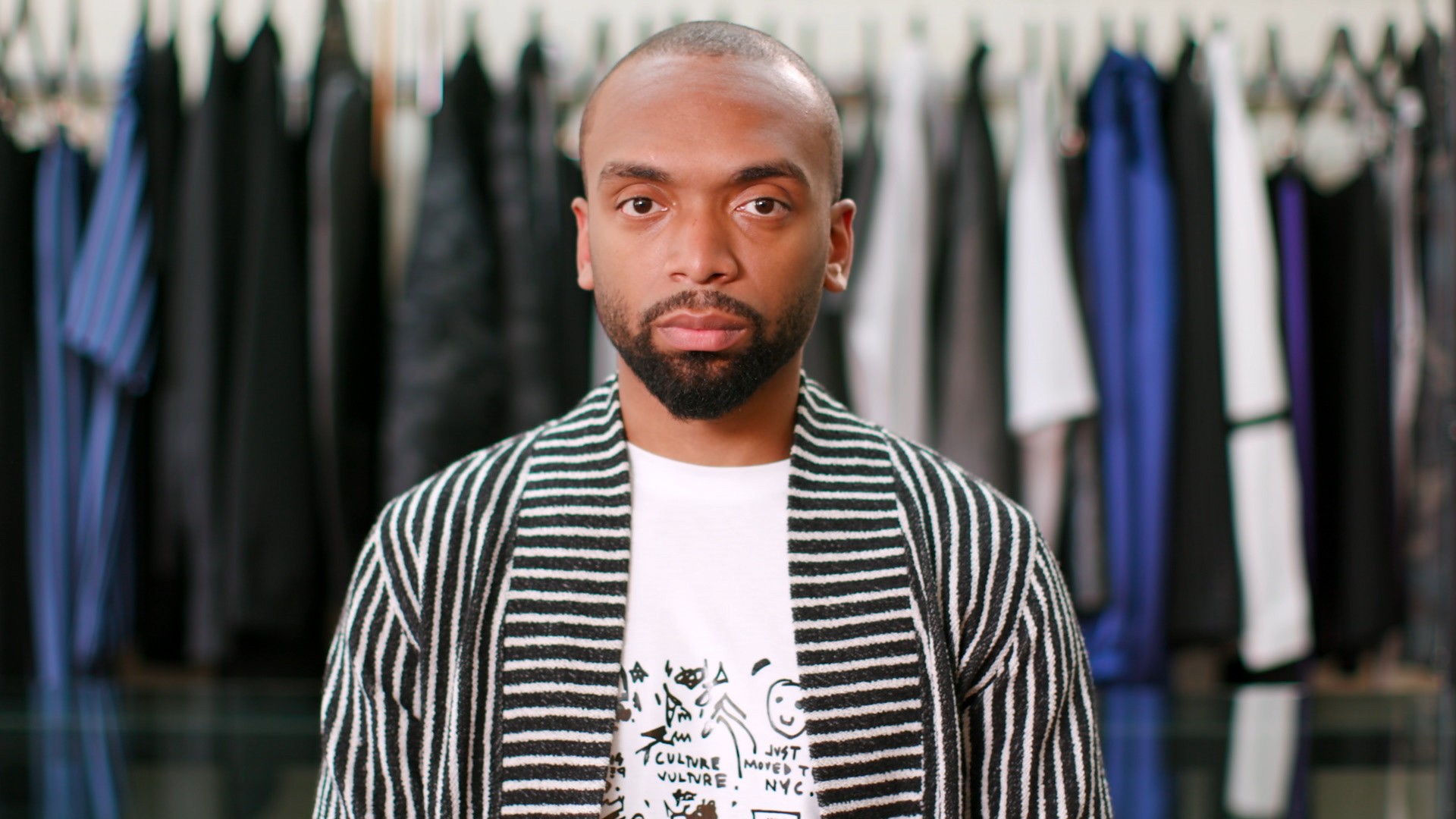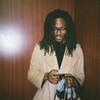The cholo subculture is contentious. Even among some Mexican Americans, the street-wise aesthetic that was birthed in East Los Angeles's Chicanx community can get derided for its resistance to white American assimilation and its loose affiliation with gangsterism. But for fashion designer Willy Chavarria, the spirit of the cholo is everything. His eponymous label embraces the unique style that he saw growing up in California in the 80s and 90s, taking the looks of the Chicanxs prowling the streets of LA in lowriders and transporting that to the vaunted runways of New York Fashion Week.
Advertisement
Traditionally, the cholo look is typified by workwear basics, like clean button-down shirts and oversized Dickies. The khakis in particular are worn with tight belts that cinch the waist and create pleats. The backs of the pants are often pinned up so that they don't drag on the floor. Today, Chavarria's interpretation of this style comes in both denim and wool, with oversized waist bands that are folded and snapped into place to create the same effect."I loved the fact that [the cholo] was a distinct identity," the Mexican American designer said to me inside his flagship store in Manhattan's SoHo neighborhood. "It was about taking these clothes that weren't high fashion and making it high fashion. I always appreciated that." You can see this approach in everything he does, like the extra long belt from the brand's recent collaboration with Brandblack, which looks like it could easily be an heirloom passed down from a tough older brother.
Willy Chavarria. Photo by Meron Menghistab
Born in the San Joaquin Valley as an only child to a Mexican father and an Irish American mother, the arts weren't held in high esteem in Chavarria's household. "If you're coming from an immigrant family, it's all about putting food on the table," the 49-year-old said. "The arts isn't really something you think about making money from, so I was actually discouraged from drawing or anything like that."While Chavarria didn't work the fields picking lettuce like many of his friends, at the age of 12 he was already washing dishes in restaurants, earning his keep. But despite the emphasis on traditional labor in his community, he always nurtured his artistic side. Even at the age of five, he was sketching in address books. And later on, he collected and fetishized glossy fashion magazines, wrote poetry, and explored graphic design.
Advertisement
The environment in which he grew up also made him keenly aware of race. In his hometown, "there was a lot of segregation between white and brown," he explained. Even in his own family, he remembers how his white mother became estranged from her family after getting with his Mexican dad. "In the white part of town [before I was born], there used to be a sign that said, 'If you're brown, don't let the sun go down on you.'"These experiences, coupled with the subliminal politics of the cholo scene, instilled a sense of purpose into Chavarria. "I decided at a very early age that anything I did was going to have a political connotation," he explained. "I wanted to make sure I was giving a voice to oppression and people being oppressed."
For a guy who got his start in fashion later than most—"I got off track," he explained with a laugh—Chavarria's got a glowing résumé. He started off at Joe Boxer in the mid 80s while studying graphic design at the Academy of Art in San Francisco. An initial job in the shipping department ended with him designing side by side with Nick Graham, the company's founder. That role turned into one at Voler, where Chavarria helped work on designing cycling apparel, eventually getting looped in to do the outsourcing for Ralph Lauren's RLX line of performance apparel. The designer did so well with that job, eventually the New York–based fashion company brought him in-house, relocating him from California.
Advertisement
Chavarria did five years at what the industry calls "Ralph Lauren University," touching every aspect of design. "When I resigned, my boss was furious," Chavarria recounted. "He told me, 'This isn't a training ground for you to learn how to design and then go somewhere else." Except, in a sense, it was. The halls of Lauren have birthed a generation of American menswear designers including heavyweights like Joseph Abboud, Thom Browne, John Varvatos, and Todd Snyder.
WATCH: Designer Kerby Jean-Raymond Mixes Politics and High Fashion
"When I was working there, it was doing really well. There was a budget to put so much into the design," Chavarria said of the experience. Ralph Lauren is reportedly not doing as well now, having recently lost $204 million in the fourth quarter and shut down its flagship on Fifth Avenue in April. "We spent every moment designing, making sure everything was perfect. We would take weeks honing concepts for just an hour presentation with Ralph. For that, I am ever grateful."In October 2010, alongside his partner David Ramirez, he opened up Palmer Trading Company, a physical store selling vintage menswear, furniture, and accessories. "It was basically what I learned at Ralph," Chavarria said of the store that he ran while holding a design role at American Eagle. "To be honest, I didn't have the total passion in it because it wasn't 100 percent my soulful creation." But eventually, it put him in a position to launch his own namesake label.
WATCH: Designer Kerby Jean-Raymond Mixes Politics and High Fashion

"When I was working there, it was doing really well. There was a budget to put so much into the design," Chavarria said of the experience. Ralph Lauren is reportedly not doing as well now, having recently lost $204 million in the fourth quarter and shut down its flagship on Fifth Avenue in April. "We spent every moment designing, making sure everything was perfect. We would take weeks honing concepts for just an hour presentation with Ralph. For that, I am ever grateful."In October 2010, alongside his partner David Ramirez, he opened up Palmer Trading Company, a physical store selling vintage menswear, furniture, and accessories. "It was basically what I learned at Ralph," Chavarria said of the store that he ran while holding a design role at American Eagle. "To be honest, I didn't have the total passion in it because it wasn't 100 percent my soulful creation." But eventually, it put him in a position to launch his own namesake label.
Advertisement
Willy Chavarria. Photo by Meron Menghistab
Over time, in the midsts of the vintage pieces, Chavarria began an in-house label for Palmer Trading Company. It was primarily American workwear, manufactured domestically. It was doing well, picking up one-off collaborations and joining with Dickies in a partnership that ends this season."Our showroom in Japan was feeling what we were doing, and they asked us to do something more, so we decided to do the Willy label," Chavarria explained. For fall 2015, its debut season, the label was just sold in Japan as a more fashion forward, higher-end line. But demand for it grew so much that it launched in the US the following season, eventually being sold at retailers like Opening Ceremony and Barneys. So Willy decided to go all in, and he rebranded Palmer Trading Company as Willy Chavarria.From its beginnings, Chavarria's label has been a platform for political expression. But the label's debut presentation at New York Fashion Week this February may have been its loudest yet. Personally chosen by the CFDA to show as a part of the week, the inaugural Willy Chavarria show commented on the election of Donald Trump and the current political climate."When I was designing the collection, I knew it had this element of resistance to oppression," Chavarria explained. "During the year, things were getting more and more ugly… I wanted to show the power and dignity and elegance of people who are generally oppressed."
Advertisement
From Willy Chavarria's "The Ameri-cans" lookbook. Photo by Carlos Jaramillo
Before the show, Chavarria cued it all up with a series of casting call fliers on his brand's Instagram. The fliers called for "sexy wet backs," "brown immigrants," and those who were "black and proud," as well as candidates who happened to be "beat to the gods." For the designer, it was about appropriating these terms and re-contextualizing them into positives. The connecting thread was that they all had intolerance for hate."I wanted to make people react to those ads and want to be involved" Chavarria said. For all of the brand's projects, Chavarria typically streetcasts models, putting an emphasis on those outside of fashion's narrow definitions of beauty. "I wanted it to be emotional and bring in people who were already on that tip."
From Willy Chavarria's "Fuck Hate" lookbook. Clothes are in collaboration with Brand Black. Photo by Carlos Jaramillo
First, the showcase that was choreographed by Marlon Taylor-Wiles featured models locked inside a cage, evoking the idea of immigrant detainment. The choice felt particularly timely in light of Trump's proposed travel ban. Laced into the soundtrack of the show were the distorted voices of Cesar Chavez, Martin Luther King Jr., and RuPaul."There's a positivity in what we do that I'm always conscious of," Chavarria said when asked whether the the political bend of the show has had any repercussions. "Even when we're building the show, we want the brand to make a statement, but also leave people feeling good. We don't want to make people feel guilty or excluded." The designer went on to say that beyond the dissolution of one long-term partnership, the label has had no negative feedback for its political statements.
Advertisement
For spring 2018, Chavarria plans to collaborate with artist Brian Calvin, who he grew up with in Visalia, a city in the San Joaquin Valley of California. Calvin is a contemporary figurative painter whose brightly colored work revolves around youth. Their joint project will feature Calvin's work and is focused on highlighting the beauty of emergence from oppression, while still layered over a cholo-inspired base. "That [cholo] look is omnipresent in our design," Chavarria explained to me. "It's what I grew up with. But it's everywhere, it's crossed over into so many territories, even skater culture took that look."Chavarria is intent on taking it back.Follow Mikelle Street on Twitter.All photos of Willy by Meron Menghistab. Follow him on Instagram.
